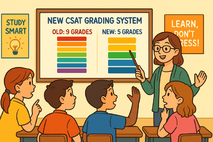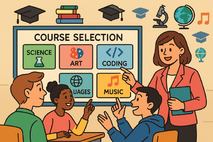Column
전체기사 보기-

A New Grading System for Korea’s College Exam: What Will Change?
A New Grading System for Korea’s College Exam: What Will Change? Many Korean students dream of going to university, and one big step toward that dream is the Suneung, or Korean College Scholastic Ability Test (CSAT). Right now, this test uses a 9-grade system to rank students' scores. But soon, that will change. The government is planning to change the CSAT grading system from 9 grades to 5 grades. What does this mean for future test-takers — and for younger students like middle schoolers who will face this system one day? Let’s explore. What Is the Current 9-Grade System?Under the current sys
-

Discovering Yourself: The Free Semester System in Korea
Discovering Yourself: The Free Semester System in Korea Imagine going to school for a whole semester with no pressure from big exams. Sounds exciting, right? That’s exactly what Korea’s 자유학기제, or Free Semester System, is all about. Since 2016, this system has been offered in middle schools across the country. But why was it introduced? And what do students really think about it? Let’s take a closer look. What Is the Free Semester System?The Free Semester System allows middle school students to spend one semester focusing on exploring their interests, talents, and dreams — without worrying abou
-

Korea’s High School Credit System: A New Path or a New Challenge?
Korea’s High School Credit System: A New Path or a New Challenge? Big changes are coming to Korean high schools. Starting in 2025, the High School Credit System — known in Korean as 고교학점제 — will be fully introduced across the country. But what does this mean for students like us? Is it an exciting opportunity, or does it bring new challenges? Let’s take a closer look. What is the High School Credit System?Until now, most high schools in Korea followed a fixed curriculum. All students in the same grade studied nearly the same subjects, regardless of their interests or future goals. The new syst
-

Korea’s High School Credit System: A New Path or a New Challenge?
Korea’s High School Credit System: A New Path or a New Challenge? Big changes are coming to Korean high schools. Starting in 2025, the High School Credit System — known in Korean as 고교학점제 — will be fully introduced across the country. But what does this mean for students like us? Is it an exciting opportunity, or does it bring new challenges? Let’s take a closer look. What is the High School Credit System?Until now, most high schools in Korea followed a fixed curriculum. All students in the same grade studied nearly the same subjects, regardless of their interests or future goals. The new syst
- 관리자 기자
- 2025-06-09 23:16
-

The Bright Future of AI in English and Math Education
The Bright Future of AI in English and Math Education Have you ever imagined a classroom where a friendly robot helps you write a story or solve a tricky math problem? This is no longer just science fiction — thanks to AIDT, or Artificial Intelligence Digital Textbook, the way we learn is changing faster than ever before. AIDT means using smart computer programs to improve education. In English and math, AI is already making lessons more fun, personal, and effective. Smarter English LearningAI tools can now read your writing and suggest better words or grammar. They can also help you practice
- 관리자 기자
- 2025-06-09 23:08
-
 Entertainment · Broadcasting
Fair Play Menarini International Award, 29th Award Ceremony marked by waves of emotion
Entertainment · Broadcasting
Fair Play Menarini International Award, 29th Award Ceremony marked by waves of emotion
-
 Entertainment · Broadcasting
The Rose, the first Korean band to perform at Coachella, confirms Seoul concert on August 30 for “Once Upon a WRLD”
Entertainment · Broadcasting
The Rose, the first Korean band to perform at Coachella, confirms Seoul concert on August 30 for “Once Upon a WRLD”
-
 Culture · Events
Incheon Port Authority kicks off the 6th Incheon International Marine Forum in Songdo, Incheon, to look into the future of the global marine industry
Culture · Events
Incheon Port Authority kicks off the 6th Incheon International Marine Forum in Songdo, Incheon, to look into the future of the global marine industry
-
 Culture · Events
Seocho Symphony Orchestra to hold performances in Berlin, Germany, and London, England, commemorating the 80th anniversary of liberation and the 75th anniversary of the Korean War
Culture · Events
Seocho Symphony Orchestra to hold performances in Berlin, Germany, and London, England, commemorating the 80th anniversary of liberation and the 75th anniversary of the Korean War
-
 Culture · Events
Gyeonggi Province to hold its largest job fair for middle-aged and older workers on the 9th. 1,000 jobs to be filled.
Culture · Events
Gyeonggi Province to hold its largest job fair for middle-aged and older workers on the 9th. 1,000 jobs to be filled.
-
 International
Jeju's soul resonates in Rome... Singing of the pain and reconciliation of Jeju 4·3
International
Jeju's soul resonates in Rome... Singing of the pain and reconciliation of Jeju 4·3
-
 International
Seoul City establishes a foothold for K-Beauty and fashion to enter the European market, promoting Milan as a base
International
Seoul City establishes a foothold for K-Beauty and fashion to enter the European market, promoting Milan as a base
-
 Medical · Health
Korean Centers for Disease Control and Prevention: Increase in hand, foot, and mouth disease among infants and young children! Follow preventive measures and maintain good hygiene to stay healthy.
Medical · Health
Korean Centers for Disease Control and Prevention: Increase in hand, foot, and mouth disease among infants and young children! Follow preventive measures and maintain good hygiene to stay healthy.
-
 Medical · Health
Korean Centers for Disease Control and Prevention: Injured patients account for the largest proportion of hospitalized patients; falls are the main cause
Medical · Health
Korean Centers for Disease Control and Prevention: Injured patients account for the largest proportion of hospitalized patients; falls are the main cause
-
 Medical · Health
WHO and international health experts visit Wanju local food production sites
Medical · Health
WHO and international health experts visit Wanju local food production sites
오피니언
-
Seong Ki-sun's Book Launch Event ‘Education in Turmoil’...Seeking Hope for Public Education Through Basic, Relationship, Growth (BRG)
On the 6th, the publication celebration for Professor Sung Ki-sun's (Catholic University of Korea, former President of the Korea Institute for Curriculum and Evaluation) book ‘Educational Turmoil’ was held at the Gyeonggi University Teleconvention Center. Sung was the 2022 Democratic Progressive Single Candidate for Gyeonggi Superintendent of Education. The event was a great success, attended by approximately 800 key figures from education, politics, academia, civic groups, and the public. Attendees included Gyeonggi Province Governor Kim Dong-yeon, Bucheon Mayor Cho Yong-ik, former Minister o
-
JP EDU - Hidden Opportunities in Japan: English-Taught International Studies Programs Open Doors to Prestigious Universities
Can you enter a top Japanese university without speaking Japanese? Can you enter a top Japanese university without speaking Japanese? Surprisingly, the answer is yes. Much like Korea’s Yonsei University Underwood International College or the Songdo Global Campus, more than 40 Japanese universities now offer full-degree programs conducted entirely in English. These English-taught programs—often called G30 programs—are especially popular in the field of International Studies. Admission is based on a student’s academic record (GPA) and English proficiency, rather than Japanese language ability. A
-
대한민국영어신문 주니어 영어 기자단 모집 (2026년 제 1기)
대한민국영어신문 주니어 영어기자단 모집 안내영어로 세상을 보고, 글로 성장하는 주니어 기자단! 1. 모집 대상 모집 인원: 총 00명 한정 모집 지원 자격: 초등학교 2학년 ~ 고등학교 2학년 학생 및 동일연령 청소년 (영어에 관심이 있고, 글쓰기와 인터뷰 활동에 도전하고 싶은 학생 누구나) 2. 활동 내용 영어신문 기자로서 기사 작성, 인터뷰, 취재, 콘텐츠 기획 참여 온라인 영어 학습 콘텐츠 무료 제공 및 기사 첨삭 지도를 통한 영어 실력 향상 정기 영어 특강, 현장 캠프, 멘토링, 전문가 영어학습 컨설팅 제공 작성한 기사는 대한민국영어신문 공식 온라인 플랫폼에 게재 3. 혜택 및 특전 영어기자증 발급 및 임명식 진행 우수기자 시상 및 특전 제공 1:1 기사첨삭 및 학습 피드백 온라인 영어 학습 콘텐츠 무료 제공 연간 36회 이상 기사 게재 기회 부여 -> 공식 칼럼 섹션 제공 4. 모집 일정 1차 신청 기간: ~ 2025년 11월 28일(금)까지 2차 신청 기간: ~ 2025년 12월 26일 (금)까지 신청 방법: 1) 대한민국영어신문 홈페이지 온라인 폼 신청 * 아래
-
Lotte Scholarship Foundation Provides 300 Job Seekers with 300 Million Won in Scholarships and Employment Training Support
The Lotte Scholarship Foundation (Chairwoman Jang Hye-seon) held the “Shin Kyuk-ho Lotte Scholarship Award Ceremony for Job Seekers” on Tuesday, May 5, at the Lotte Retail Academy in Yeongdeungpo-gu, Seoul, and presented a total of 300 million won in scholarships to 300 job seekers in the media and engineering fields. This year's scholarship recipients will each receive a living expense scholarship of 1 million won, and will also have the opportunity to participate in various job experience education programs to learn about their desired fields and develop their expertise. The education progra
-
Lotte Scholarship Foundation to Provide 270 Million Won in Scholarships to 100 Teenage Mentors
The Lotte Scholarship Foundation (Chairwoman Jang Hye-sun) held the “Shin Geuk-ho Lotte L-Bridge Scholarship Award Ceremony” on Thursday, March 31, at the Kyowon Tour Concert Hall in Jongno-gu, Seoul, and announced that it would award a total of 270 million won in L-Bridge scholarships to 100 scholarship recipients this year. The Shin Geuk-ho Lotte L-Bridge Scholarship is a scholarship program that supports teenagers in low-income families and out-of-school teenagers who are facing challenges in their education and growth. It helps them develop into talented individuals who can practice the va
-
Rethinking the Way We Handle the High School Credit System
Rethinking the Way We Handle the High School Credit System (고교학점제) School should not be a place where every student is forced into the same mold, but a space where different talents and dreams are nurtured. The High School Credit System (고교학점제), scheduled to be fully implemented in Korea by 2025, is a bold step toward personalized learning. Its goal is to give students more choice in what they study — allowing them to take courses that match their interests, abilities, and future goals, much like in a university setting. But as the system moves from theory to practice, important challenges are
-
2025-12-09 14:30
Seong Ki-sun's Book Launch Event ‘Education in Turmoil’...Seeking Hope for Public Education Through Basic, Relationship, Growth (BRG)
-
2025-11-04 13:48
JP EDU - Hidden Opportunities in Japan: English-Taught International Studies Programs Open Doors to Prestigious Universities
-
2025-10-27 11:03
대한민국영어신문 주니어 영어 기자단 모집 (2026년 제 1기)
-
2025-08-07 01:19
Lotte Scholarship Foundation Provides 300 Job Seekers with 300 Million Won in Scholarships and Employment Training Support
-
2025-08-01 09:42
Lotte Scholarship Foundation to Provide 270 Million Won in Scholarships to 100 Teenage Mentors

대한민국영어신문 주니어 영어 기자단 모집 (2026년 제 1기)
대한민국영어신문 주니어 영어기자단 모집 안내영어로 세상을 보고, 글로 성장하는 주니어 기자단! 1. 모집 대상 모집 인원: 총 00명 한정 모집 지원 자격: 초등학교 2학년 ~ 고등학교 2학년 학생 및 동일연령 청소년 (영어에 관심이 있고, 글쓰기와 인터뷰 활동에 도전하고 싶은 학생 누구나) 2. 활동 내용 영어신문 기자로서 기사 작성, 인터뷰, 취재, 콘텐츠 기획 참여 온라인 영어 학습 콘텐츠 무료 제공 및 기사 첨삭 지도를 통한 영어 실력 향상 정기 영어 특강, 현장 캠프, 멘토링, 전문가 영어학습 컨설팅 제공 작성한 기사는 대한민국영어신문 공식 온라인 플랫폼에 게재 3. 혜택 및 특전 영어기자증 발급 및 임명식 진행 우수기자 시상 및 특전 제공 1:1 기사첨삭 및 학습 피드백 온라인 영어 학습 콘텐츠 무료 제공 연간 36회 이상 기사 게재 기회 부여 -> 공식 칼럼 섹션 제공 4. 모집 일정 1차 신청 기간: ~ 2025년 11월 28일(금)까지 2차 신청 기간: ~ 2025년 12월 26일 (금)까지 신청 방법: 1) 대한민국영어신문 홈페이지 온라인 폼 신청 * 아래

No. 5 Reporter
Sophia Lee – Grade 7, Cedar Hills Middle School Hello, I’m Sophia Lee from Cedar Hills Middle School. I love reading mystery novels and listening to podcasts about true stories. I joined the Junior English Journalists because I want to write articles that are thoughtful and help people see things differently. I want to write about nature, the environment, and young people’s ideas for change. My dream is to become an environmental journalist who works for National Geographic.




















